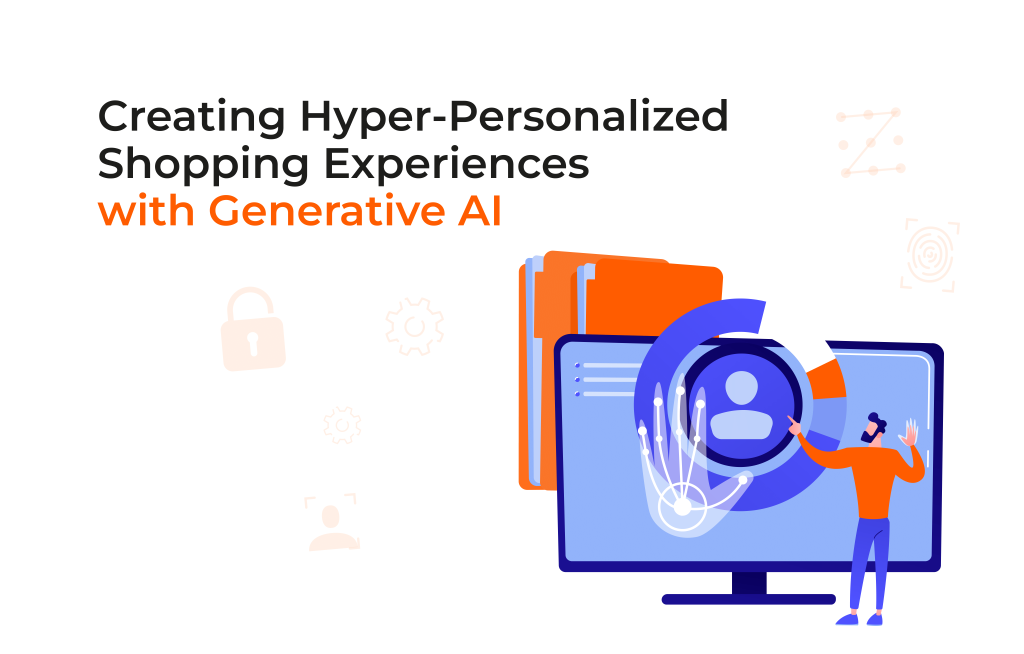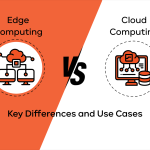Picture giving each shopper on your site a personalized shopping experience that speaks to their unique tastes, interests, and actions. For years, brands tried this using simple rules and broad categories. Now, there’s a better way. Enter Generative AI (GenAI) – a technology that builds real-time, custom journeys for every visitor. This approach leads to higher revenue, deeper engagement, and stronger loyalty.
In this article, we’ll show how GenAI changes retail into a realm of one-to-one experiences. We’ll also explore how AWS tools and IT-Magic’s services help you create journeys that stand out.
The rise of Generative AI in retail
Retail AI began with rule-based engines. Those systems could only follow fixed instructions. Then, we moved to machine learning that recognized patterns. Today, we have Generative AI, which goes further. It doesn’t just automate tasks, it creates fresh outputs in real time.
Look at history: older e-commerce sites had a single greeting for all visitors. That might have worked when online shopping was new. Now, shoppers expect more. Generative AI adapts on the fly and adjusts each offer, tone, or next step for every session. This transforms a static store into a live environment tuned to each user’s needs.
Research from MarketsandMarkets shows the GenAI market will grow fast. That’s because it can deliver the potential for better service, higher conversion, and improved loyalty. Early adopters in e-commerce often gain an edge over slower rivals.
Generative AI is not just a content tool – it’s a personalization engine
Many people see GenAI as a system that writes text or creates images. But there’s more under the surface. GenAI takes in data about a shopper’s history and behavior. It also looks at the user’s current context. It then generates text, images, or suggestions that match each moment. That’s possible because the AI can understand user intent and adapt its outputs with lightning speed
The leap from static recommendation engines to AI that crafts real-time, context-aware experiences
Old recommendation engines did simple matching. They’d say, “People who viewed this also liked…” That helps, but it uses past data only. GenAI changes this model. Now, it can see how long a user hovers, what pages they read first, and what they do next. The system might say: “Because you checked X right after reading Y…” or provide a chatbot tip that reads the user’s micro-signals. That’s a different level of a personalized shopping experience. It reflects immediate actions in the shopper’s journey.
Why personalization is the cornerstone of customer loyalty and higher revenue
With personalization, shoppers can find what they want. They feel seen and appreciated. That raises the chance they’ll buy more items and stick around longer. It boosts AOV (average order value) with relevant cross-sells and upsells. Over time, it drives lifetime value because happy buyers return again and again.
A unique personalized shopping experience also helps your brand stand out. In a crowded market, it’s easy to switch to a competitor. When your store “gets” each shopper’s needs, you reduce that risk.
Quick statistics
A McKinsey & Company study found that 78% of consumers are more likely to stay loyal to a brand that offers personalized campaigns and offers. This underscores the potential of true, real-time hyper-personalization.
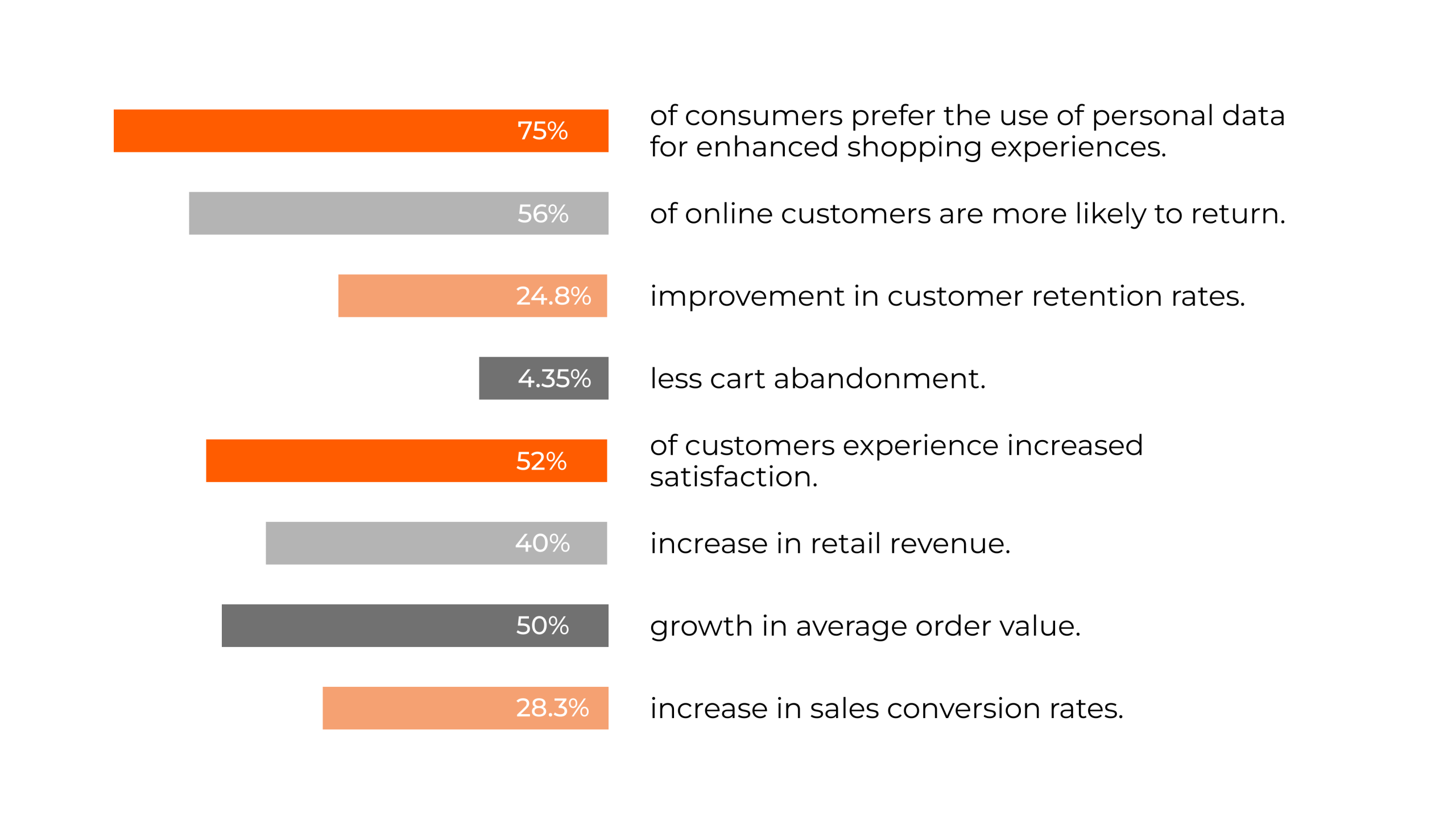
What is hyper-personalization and why it matters now
Hyper-personalization goes deeper than basic name inserts or broad segments. It crafts a one-to-one customized shopping experience for each user, at scale. That means the right message at the right time for the right person.
Personalization strategy
Placing personalization at the core of your online store transforms the customer journey. You address every stage: product discovery, browsing, purchase, and follow-up. This yields gains in:
- Engagement: People spend more time on the site.
- Loyalty: They return because they feel valued.
- Sales: Relevant products appear when they’re most wanted.
Combines behavioral data, preferences, and real-time context
Hyper-personalization collects input from many places: clickstreams, history, device type, location, and more. Shoppers behave differently on mobile vs. desktop. GenAI merges these signals to deliver content that fits each moment. It’s like a system that listens to every move a user makes, then reacts on the spot.
Shift from segmentation to 1:1 experiences at scale
Segmentation groups shoppers by demographics or a shared interest. That still helps, but it falls short when buyers want personalized details. Hyper-personalization with GenAI focuses on the individual. Rather than “women ages 25–35,” you target “Susan, who looked at running shoes and reads sports gear blogs weekly.” GenAI can handle these unique stories for countless users.
GenAI enables the dynamic creation
GenAI changes how content is produced for each user. Here are some main areas of personalized shopping experience:
- Product descriptions that reflect user interests
- Personalized landing pages, emails, and promotions
- Conversational interactions (AI shopping assistants) in natural language
Key use cases of Generative AI in e-commerce personalization
GenAI shines in real-world scenarios. Below are core ways it helps stores personalize content for each visitor.
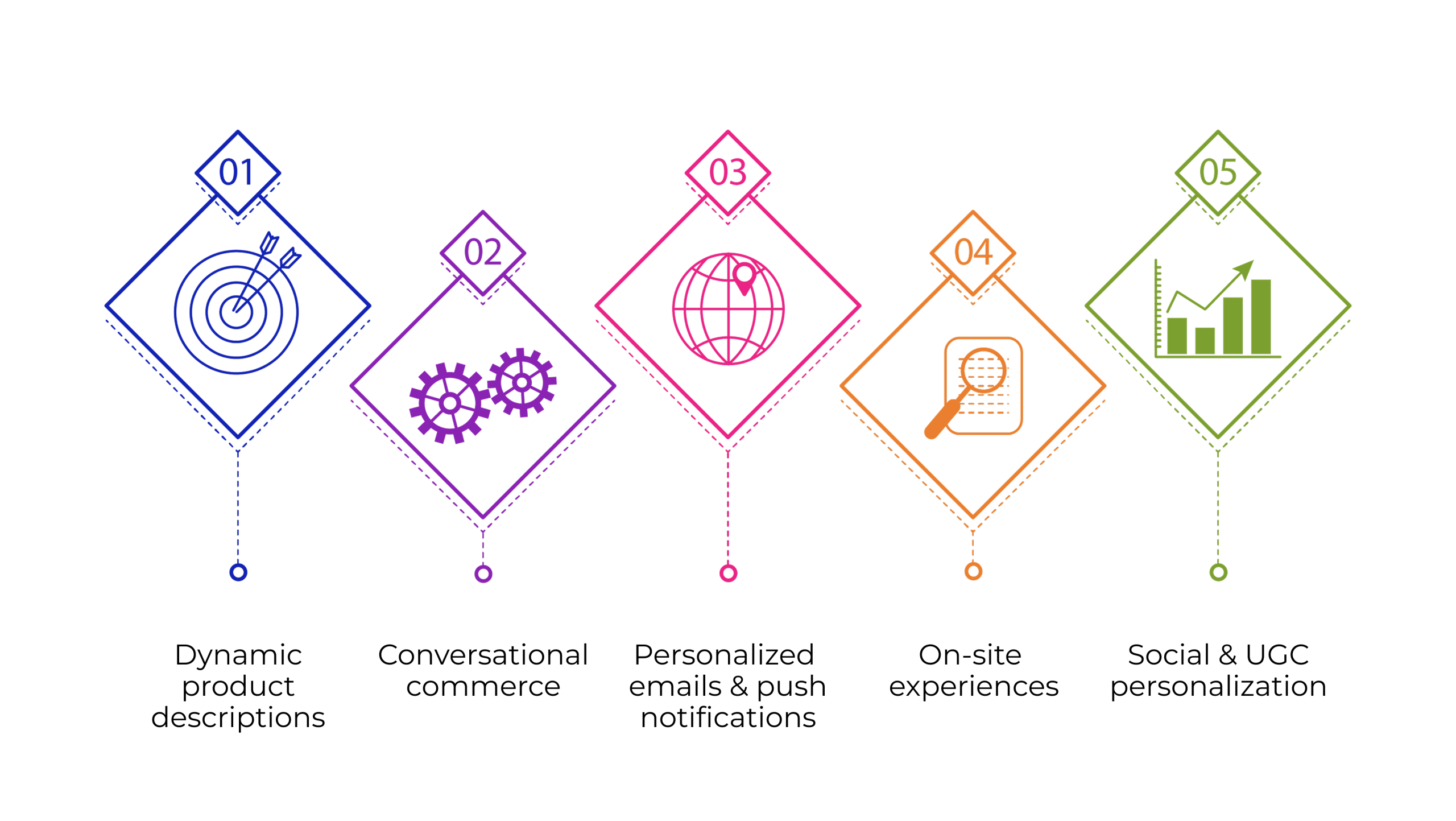
Dynamic product descriptions
Problem: Sites often use static product text. It doesn’t speak to a wide range of shoppers.
How GenAI solves it: AI creates fresh, context-aware copy. It checks past behavior, history, or even time of day. Then it writes text that feels relevant and contributes to customized shopping experience.
Result: Better engagement and a higher chance of conversion. Shoppers read text that resonates.
Tailored copy based on user history, region, language, or intent
Imagine you sell a dress. A fashion-forward Gen Z buyer sees edgy style tips and color match ideas. A busy mom sees text about comfort and easy care. The AI picks up those clues from click patterns and browsing data.
Conversational commerce
Problem: Standard chatbots stick to scripts, which cannot ensure a personalized shopping experience. They rarely hold a fluid conversation.
How GenAI solves it: GenAI chatbots adapt to each user’s mood and details. They remember if the user has an event soon. They also shift tone, offering gentle suggestions or direct upsells.
Result: Shoppers feel heard. They also find what they need faster. This boosts cart sizes and lowers support costs.
Chatbots that recommend products, answer questions, and upsell – all in natural language
Picture a user shopping for formal attire. They type, “I’m looking for something navy and stylish for a wedding.” The AI replies: “Here are our top picks. By the way, do you need matching shoes?” That approach is more personal than a static FAQ bot.
Personalized emails & push notifications
Problem: Generic emails often see low open rates. Many push notifications feel irrelevant and get ignored.
How GenAI solves it: AI personalizes each subject line, body text, and CTA. It also sends them at the best times, guided by user behavior.
Result: More opens, clicks, and conversions. People respond to messages that match their interests or recent site actions.
Copy and offers generated in real time based on user triggers
A typical cart abandonment note might say, “You left something behind!” With GenAI, the email can mention the exact item and offer a relevant discount. It can also tailor the tone to the user’s shopping style for a better personalized shopping experience.
On-site experiences
Problem: Many sites present the same homepage to all. Repeat shoppers see no new info, and new visitors miss a friendly intro.
How GenAI solves it: By tracking session data, AI changes page layouts and content elements in real time. Returning buyers might see a discount on items related to past purchases. First-timers might get a guide to best-selling products.
Result: Less bounce and greater engagement. Each visitor gets a view that speaks to them.
GenAI-generated banners, categories, and featured items based on session behavior
Consider the difference between a first-time user and a loyal returning buyer. The loyal buyer sees content that addresses their past purchases. They might also get a “thank you” discount for an add-on. A new user sees brand highlights and top sellers. Such a customized shopping experience causes better customer loyalty.
Social & UGC personalization
Problem: Social feeds or reviews can overwhelm users. People won’t sift through everything if it doesn’t seem relevant.
How GenAI solves it: AI can target the right influencer or generate on-the-spot influencer-like content. It predicts what user-generated posts a shopper might trust. If someone looks at hiking boots, they see a short video from an outdoors influencer.
Result: Users connect with content that fits their style or needs. They see proof from real users, not random items.
Tailored influencer content, video recommendations, or GenAI-generated visuals
GenAI can create images of an item in various settings, like city streets vs. mountain trails. It can also suggest influencer clips that match the shopper’s experience or region. This approach makes the platform feel alive.
_______________________________________________________________________
Want to unlock AI-driven personalization to create personalized shopping experience for your customers?
AWS-powered GenAI can turn your store into a high-conversion powerhouse. Our team will handle the implementation and support.
_______________________________________________________________________
AWS tools for deploying generative personalization
AWS services provide flexible building blocks. They help you ingest and process data, train models, and deploy GenAI at scale. IT-Magic’s expertise ties these tools together so everything runs smoothly.
Amazon Bedrock – Foundation models without infrastructure
Amazon Bedrock offers pre-trained models via simple APIs. You don’t have to set up large servers or manage complex hardware. You use your data and brand style to fine-tune the model. Then, you link it to your e-commerce site. This pay-as-you-go model keeps costs clear and predictable.
SageMaker JumpStart – Fine-tuning for e-commerce
SageMaker JumpStart gives you templates and pre-built model checkpoints. You can fine-tune models like Falcon or LLaMA with your user data, product info, and marketing text. It helps you build a custom model with a voice that matches your brand.
AWS Lambda – Real-time GenAI generation
Personalized shopping experience often demands quick responses. AWS Lambda triggers GenAI tasks the moment a user clicks or views a page. It scales automatically. You only pay for the time used by your function. This is perfect for demand spikes, since your capacity expands as needed.
S3 & CloudFront – Dynamic asset delivery
Once your AI creates banners or product copy, you must serve them fast. S3 stores them securely and cheaply. CloudFront delivers them to users worldwide with low latency. This pairing keeps your site quick even under heavy loads.
Amazon Personalize – GenAI & predictive recommendations
Amazon Personalize is strong on behavioral recommendations. Paired with a GenAI model, it can deliver advanced features. The system might not only suggest items, but also explain why it chose them. This helps users understand the logic behind your offer.
EventBridge & Step Functions – Behavior-based workflows
EventBridge allows event-driven tasks. If a user views a specific product, Step Functions can trigger a GenAI workflow. That might create a one-time email, schedule a push alert, or design a custom landing page. It’s all automated, so you don’t rely on manual tasks.
Results you can expect from hyper-personalization
What happens when you merge GenAI with these AWS tools? You get real improvements in core metrics, plus better customer trust and brand appeal.
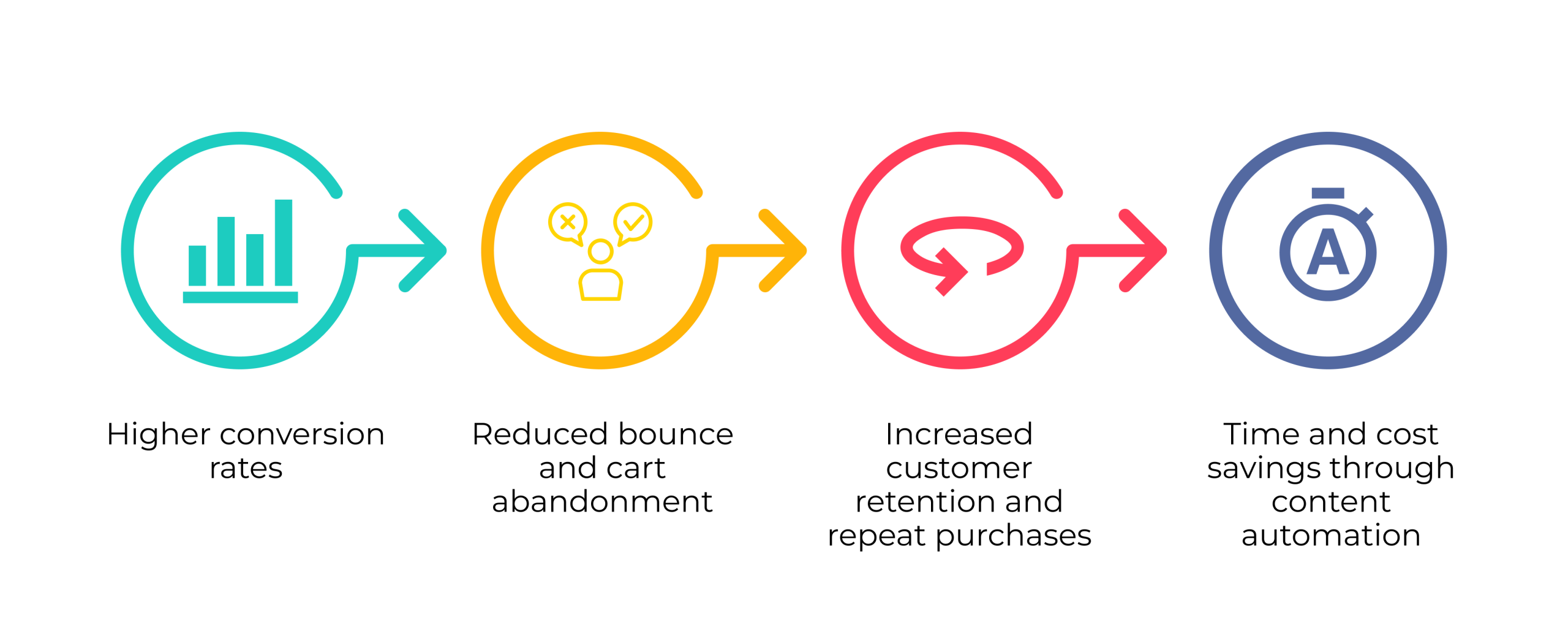
Higher conversion rates
Personalized paths remove friction. Shoppers see relevant items fast. That simpler journey leads to bigger order totals and fewer abandoned carts.
Reduced bounce and cart abandonment
When each page feels tuned to the user’s preferences, people stick around. Smart follow-ups, like targeted emails or pop-ups, also reduce cart abandonment. They remind shoppers of what they liked, paired with the right offer.
Increased customer retention and repeat purchases
A personalized shopping experience approach keeps users coming back. They feel valued. They also receive timely outreach with new or related items. Over time, these repeat visits build loyalty.
Time and cost savings through content automation
Writing product descriptions and ads can be expensive. GenAI removes the need to manually draft each line of text. You free your teams to do other tasks, like strategy, design, or business expansion.
Challenges & considerations
Every new technology has roadblocks. Knowing them upfront helps you handle them better.
Prompt tuning and hallucination control
Sometimes, AI creates content that isn’t factual or is off-brand. Prompt tuning keeps the model within approved language or facts. Clear guidelines help the AI stay correct and relevant. This step is key to good results in creating personalized shopping experiences.
Performance optimization for real-time content generation
Real-time AI can tax your resources. A store needs to stay quick during peak times. AWS solutions handle scaling well, but you still need the right architecture to ensure fast responses.
Managing tone/brand consistency at scale
When AI writes so much copy, it might drift from your brand’s style. Marketing and tech teams must set guardrails and monitor the results. Regular check-ins keep the tone steady across all channels.
Monitoring content for quality and compliance
Some products are regulated. Other industries have strict rules about claims. You must review AI outputs to stay legal. Regular audits or automated checks can detect risky or incorrect text. This protects your brand image.
Getting started: What you need
If you’re a manager or tech lead, here’s a quick checklist for deploying hyper-personalization.
Behavioral data pipeline or CDP (Customer Data Platform)
A CDP gathers and stores user details: page views, prior purchases, click paths, and more. This data fuels the AI. If your data is out-of-date or missing, the AI can’t create relevant content for personalized shopping experience.
Clear customer segmentation and journey mapping
Even if you aim for one-to-one experiences, it helps to know the main user paths. Identify key points in the buyer’s journey. Focus on those places for AI-driven personalization first.
Cloud-native architecture for real-time compute
Serverless or container-based approaches on AWS let you react fast. Your system can handle traffic surges and deliver immediate outputs. This ensures a smooth personalized shopping experience with minimal delay.
Collaboration between marketing, product, and DevOps/AI teams
All teams must align. Marketing defines the brand voice. The product sets the features. DevOps and AI groups handle the technical side. When these teams talk often, the results are more consistent.
Final thoughts: From static journeys to AI-powered engagement
Hyper-personalization was once a future dream. Now it’s real, thanks to Generative AI. A personalization shopping strategy driven by GenAI takes your store to the next level. The data is there, waiting to be used in smarter ways.
Every store visitor deserves a unique journey. That could be a banner tailored to them, a personal discount, or a chatbot that “knows” their style. GenAI makes this possible at scale.
GenAI: Personalized content, tone, and timing for every shopper
The AI studies user history, context, and brand guidelines to create a personalized shopping experience. Then it adjusts every output, from product copy to email text. That ensures your store resonates with each person who arrives.
AWS powers it – IT-Magic builds, scales, and optimizes
The AWS cloud gives tools for data, computing, and security. IT-Magic fits those tools together. We handle architecture, deployment, and optimization. You focus on your business goals.
It’s time to bring your brand into the future of personalized shopping experiences starting today!
Let’s create your first GenAI-driven personalized shopping experiences!
Book a call with IT-Magic to turn your site into a hyper-personalized, high-conversion engine.
FAQ
What is hyper-personalization in e-commerce and how is it different?
Hyper-personalization goes beyond grouping people. It zeroes in on real-time behavior, location, and past campaigns. Instead of a few segments, each user sees tailored content that meets their true preferences. That makes personalization online shopping feel one-of-a-kind.
Can GenAI be integrated with our current e-commerce platform?
Yes, thanks to modular APIs and cloud-based setups. AWS services offer a flexible approach that works with many platforms. You can add GenAI features without a full overhaul. Support for real-time triggers simplifies the launch process.
Is customer data safe when using GenAI?
Yes, if you handle it properly. AWS provides encryption and governance tools. You must set strict rules to keep user information secure. That way, your system creates personalized shopping experience while respecting privacy and compliance.
What level of customization is possible?
Very high. You can alter language, visuals, or even the timing of messages. By fine-tuning models with your brand data, you ensure the outputs match your style. From dynamic landing pages to AI-driven email text, the customized shopping experience can be as detailed as you want.
